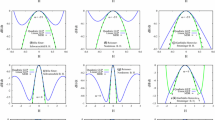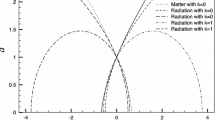Abstract
A theory that contains three fundamental constants from which one can build length, time, and mass (or force) etalons satisfies with that a necessary criterion of a “universal unified field theory.” In order to interpret such a theory physically, one has to translate it into the Galilei-Newtonian language. This leads to classical “pictures” whose compatibility is ensured by introducing appropriate measurement-theoretical principles which imply corresponding uncertainty relations. In this paper we compare different (mainly gravitational) theories from the point of view of the fundamental constants underlying each case, and of the respective uncertainty relations. Assuming Eddington's hypothesis of large cosmic numbers, it is argued in particular that in quantized general relativity one arrives at less stringent limitations on cosmology than in other conceivable approaches satisfying the principle of minimal coupling. These limitations, however, are in all cases strong enough to bar the way to quantum cosmology. Instead one is led to a Diophantean concept.
Similar content being viewed by others
References
A. S. Eddington, “Report on gravitation,”Proc. London Phys. Soc., p. 1 (1918).
A. S. Eddington,Relativity Theory of Protons and Electrons (Cambridge University Press, Cambridge, 1936).
N. Bohr and L. Rosenfeld,Det. Kgl. Dansk. Vidensk. Selkab., Mat.-Fys. Medd. 12, 1 (1933); cf. also inSelected Papers of Léon Rosenfeld, R. S. Cohen and J. J. Stachel, eds. (Reidel, Dordrecht, 1979).
V. Fock and P. Jordan,Z. Phys. 66, 206 (1930).
L. Landau and R. Peierls,Z. Phys. 69, 56 (1931).
A. Einstein,Ann. Phys. (Leipzig) 35, 686 (1911).
A. S. Eddington,Fundamental Theory (Cambridge University Press, Cambridge, 1946).
L. Rosenfeld, inEntstehung, Entwicklung und Perspektiven der Einsteinschen Gravitationstheorie, H.-J. Treder, ed. (Akademie-Verlag, Berlin, 1966); cf. also inSelected Papers of León Rosenfeld, op. cit.
H.-H. von Borzeszkowski and H.-J. Treder,The Meaning of Quantum Gravity (Reidel, Dordrecht, 1988).
A. Einstein, “Last lecture of Albert Einstein”; cf. J. A. Wheeler, “Mercer Street and other memories,” inAlbert Einstein: His Influence on Physics, Philosophy and Politics, P. C. Aichelburg and R. U. Sexl, eds. (Vieweg, Braunschweig, 1979).
H.-H. von Borzeszkowski and H.-J. Treder,Found. Phys. 20, 241 (1990).
W. Heisenberg,Einführung in die einheitliche Feldtheorie der Elementarteilchen (Hirzel, Stuttgart, 1967).
A. S. Eddington,The Expanding Universe (Cambridge University Press, Cambridge, 1937).
H. Weyl,Raum. Zeit. Materie (Springer, Berlin, 1923).
H.-J. Treder,Found. Phys. 22, 395 (1992).
H. Weyl, “Wissenschaft als symbolische Konstruktion des Menschen,”Eranos-Jahrbuch 1948, 375 (1949); cf. also in H. Weyl,Gesammelte Abhandlungen, Vol. IV (Springer, Berlin, 1968), p. 283.
W. Pauli,Physik und Erkenntnistheorie (Vieweg, Braunschweig, 1961).
A. Einstein,The Meaning of General Relativity (Princeton University Press, Princeton, 1955).
Author information
Authors and Affiliations
Rights and permissions
About this article
Cite this article
von Borzeszkowski, H.H., Treder, H.J. Quantum cosmology and Eddington's large cosmic numbers. Found Phys 24, 1077–1088 (1994). https://doi.org/10.1007/BF02054649
Received:
Issue Date:
DOI: https://doi.org/10.1007/BF02054649




